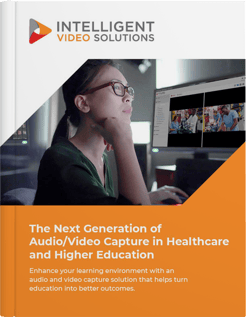Nursing directives find incentives and continuing education result in improved new nurse retention. Why? Because new nurses often wish to serve their communities to the best of their abilities and educational incentives help them develop their professional skills. How can healthcare institutions offer these educational incentives without spending a fortune? The answer lies in implementing new innovative video-audio learning tools to help new nurses with clinical case studies, training, and more. In fact, many nursing COOs find implementing these tools may be more cost-efficient than the current sign-on bonus status many organizations now use.
________________________________________
Imagine being on the receiving end of an endless stream of job offers and large sign-on bonuses. You would have no idea where to turn. The choices would be overwhelming. Unfortunately for many hospitals and healthcare provider organizations, this is the new reality in nursing. What nursing shortage experts have been predicting for years is now here, and with it come other critical problems such as new nurse job retention issues.
Students Already Have Jobs
Visit any university and note how most senior nursing students already have jobs lined up, and many of these jobs offers come with very nice incentives. There are just too few graduating nurses and this has resulted in a nursing shortage.
Most nursing officers say that shortages can run anywhere from moderate to severe but expect the situation to worsen in the next five years. And the situation not only has a negative effect on patient care but also on staff morale and retention.
What Are Nursing Officers Doing to Attract New Nurses to Open Job Positions?
According to hospital COOs, many regions are paying signing bonuses to new nurses. Even so, staff retention and development are fast becoming a big issue, and few directives know what to do or how to retain their first-year nurses.
No one questions that we have a job seekers market out there. But healthcare organizations are doing very little to attract or keep new nursing professionals. The solution lies in making an investment in quality retention programs that offer continuing education and additional support and training. It is this that will give health organizations a leg up in recruitment. However, most organizations either do not know how to implement these programs or fear the costs involved in doing so.
The Current Status Quo Is Unacceptable
The first year of a nurse’s first job is the most critical. It is here that surveys show as many as 18% of new nurses leave their first employer after just one year. So retaining new recruits needs to be a collaborative effort between management, senior nurses, and RN trainers.
Why Do New Nurses Shuffle from One Job to Another?
There are a few factors in play here and the way a healthcare organization responds to these areas of need determines whether a nurse will have a long-term job vision within an organization or not.
The Need to Focus on Educational and Leadership Opportunities
The complexity of the problems caused by the nursing shortage presents a critical need for health centers to provide stronger leadership and young professional nurse training opportunities. Hospitals and health organizations play a vital role in offering both short-term and long-term training opportunities for new nurses, yet in most current professional settings this training takes too long. On the other hand, healthcare organizations implementing video training recording platforms or other video, audio, and learning tools tend to attract more recruits and retain new nurses because of their high-tech innovation. Students turn to these institutions because they are looking for satisfying career paths.
More than The Initial Bonus
Many nursing directives believe the effective solution to retaining qualified new nurses goes beyond the initial bonus and addresses core issues in the profession which include the relationship of education to practice and the recognition of education in training and development decisions. A survey of chief nursing officers conducted by UHC has found a strong preference for hospitals functioning as the main teaching site for new health professionals. The belief is that a health center has the potential to model professionals in their nursing practice, and therefore these organizations will remain highly competitive workplaces for new professionals.
The reasons educational and training programs support developing nurses is obvious. First, resident and professional training, especially when it comes through video training platforms offer educational value to new recruits. Secondly, it provides more competent preparation for the next generation of health providers.
The Goal
The aim of an educational model within a hospital or healthcare organization is to support and implement best practices in nursing professionalism and education. Nurse leaders have identified the following benefits in implementing training and video educational platform programs within the new nursing professional integration. These include:
1. Recruit, train, retain and expand the capability of new nurse recruits.
2. Achieve an improved balance in the nursing workforce
3. Ensure a professional transition for graduates into a structured residency.
4. Offer scalable entry-level nursing salaries based on education and preparation in their chosen career pathway.
Education in the Nursing Workplace Offers
Short-term Solutions: It responds to the immediate need to prepare nurses professionally for actual real-life situations.
Improve Recruitment and Retention Rates: Successful recruitment into work-related nursing programs depends on the candidates' perception of nursing careers and advancement. Candidates need to feel valued and receive career advancement. By implementing training and educational programs entry-level nurses can see a difference.
How To Offer Education in the Nursing Workforce
● Target graduating student populations.
● Provide tuition support for advanced degrees.
● Teach through media by offering simulated situations or courses in hospital settings.
● Remove the barriers to career path progression of new nurses by offering personal and professional support through mentoring, consulting, and advising. Use case management examples to train and teach needed situational knowledge.
● Offer stimulating and useful clinical learning experiences through video learning formats.
● Create New Training Programs through Innovative VALT (Video Learning Audio Tools).
● Explore time-accelerated training methods using recorded clinical cases and make them available through a VALT platform.
● Create new professional training options in video format that allow organizations to attract qualified nursing candidates.
Increase Access to Clinical Experiences
Using education and VALT systems in the nursing work environment for new nursing professionals helps increase best practices and offers important clinical practice options and an improved working environment that qualified candidates value. Essentially what organizations with appropriate video-capturing platforms can do is:
● Expand the training capacity to share clinical case studies and offer important coursework that can take new nurses to the next level.
● Help nurse directives design clinical video learning experiences to accommodate an increased number of new nursing employees.
● Allow nurse directives to collaboratively evaluate the different ways nurses have access to clinical experiences.
● Establish social and professional networks that allow for the sharing of expertise between nursing practice centers and hospitals.
Now Is The Time to Redesign Learning Experiences
Technology, video audio learning platforms, and prerecorded simulations allow nurse trainers to explore the uses of technology and expand the ability to deliver instructional videos to nursing staff. It essentially redesigns the learning process by enhancing the clinical learning experiences.
Why Does This Matter to New Nursing Candidates?
● Increase access to nursing education programs through the development of distance education technologies.
● Increase the use of Patient Simulators and Standardized Patients as clinical learning enhancements and ways to expand learning opportunities.
● Explore technological systems to support the clinical practice of nursing and improvement of the care system.
Long-Term Solutions. Implementing educational programs in the work environment through VALT ensures that healthcare institutions have a well-educated future workforce.
Additionally, this workplace video educational system creates a career ladder system with improved reimbursement.
In The End
Staff retention is quickly becoming an issue, and while initial bonuses can be nice perks they do not lead to professional development, which is what nursing graduates seek. The solution lies in implementing educational programs using video capture platforms that allow for clinical case studies, problem-solving, and incidence training. These types of tools lead to improved nursing capabilities.
Looking for a video system to improve your healthcare training environment? Download our Guide to ensure you choose the right audio/video capture solution that enhances healthcare training and higher education.









